 2,
2,
Your responses to the Physics InfoMall search questions are due before 6 am on Monday, April 7th.
You may submit your answers to the SUBMIT FOLDER on Priscilla or as an attachment to an e-mail message to rfuller@unlinfo.unl.edu or using the above WWW link.
There is probably no topic in general physics of greater interest to physicists than simple harmonic motion. Knowing only a few facts about a SHM system, everything else can be computed, as you will soon learn. To prepare yourself for mastering SHM to the degree that will satisfy your instructor, you need to explore at least three different SHM topics on the InfoMall.
Write your solutions to the following problems and submit them before 6 am on Wednesday, April 2nd.
Submit to the SUBMIT FOLDER on Priscilla or as an attachment to an e-mail message to rfuller@unlinfo.unl.edu or using the above WWW link.
Commentary:
Have you ever felt you were the slave of a clock? Clocks are mechanisms that include a pendulum or balance wheel whose repeated patterns of movement define equal time intervals, one after another. Such repeated movements are called periodic motion. Periodic motion may occur when a particle or body is confined to a limited region of space by the forces acting on it and does not have sufficient energy to escape. In this lesson you will study the special kind of periodic motion that results when the net force acting on a particle, often called the restoring force, is directly proportional to the particle's displacement from its equilibrium position; this is known as simple harmonic motion. Actually, simple harmonic motion is an idealization that applies only when friction, finite size, and other small effects in real physical systems are neglected. But it is a good enough approximation that it ranks in importance with other special kinds of motion (free fall, circular, and rotational motion) that you have already studied. Systems that can be analyzed in terms of simple harmonic oscillations include cars without shock absorbers, a child's swing, violin strings, and, more importantly, sound waves and certain electrical circuits that you will study in later lessons.
OBJECTIVES:
Commentary:
The general equation for simple harmonic motion along the x-axis results from a straightforward application of Newton's second law to a particle of mass m acted on by a force:
F = -kx,
where x is the displacement from equilibrium and k is called the spring constant.
Since the acceleration:
a = dv/dt = d2x/dt2,
Newton's second law becomes:
-kx = m d2x/dt2,
which is called a second-order differential equation because it contains a second derivative.
We can combine the constants k and m by making the substitution:
k/m =  2,
2,
and rewrite this equation as:
d2x/dt2 = -  2x
.(1)
2x
.(1)
Your calculus background may not have acquainted you with differential equations; hence, we will discuss them briefly here without getting too fancy or formal.
Equation (1) is not like an algebraic equation for which certain constant values of x satisfy the equality.
The solution of Eq. (1) is a function of time.
Although the function
x(t) = A cos( t +
t +  ) =
A cos(
) =
A cos( ) cos(
) cos( t) -
A sin(
t) -
A sin( ) sin(
) sin( t) (2)
t) (2)
can be thought of simply as being arrived at by a very clever guess, it can be shown (by advanced mathematical techniques) to be the most general possible solution of Eq. (1).
Equation (2) can also be written in terms of two new constants B and C as
x(t) = B cos( t) + C sin(
t) + C sin( t) (3)
t) (3)
(What are the relations among B, C, A, and  ?)
?)
The velocity is then
v(t) = dx/dt =
- B sin(
B sin( t) +
t) +  C cos(
C cos( t)
(4)
t)
(4)
These last two equations are especially helpful.
For instance, if you are told that a particle begins its simple harmonic motion from rest at the point x0, you know that x(0) = x0 and v(0) = 0; hence, since cos(0) = 1 and sin(0) = 0 you immediately have:
B = x0 and C = 0.
If the particle starts at the origin (x=0) with velocity v0, then you can conclude that:
B = 0 and C = v0.
Look at the equations and check these results for yourself!
If you have a more complicated case in which the particle starts at x0 with velocity v0, then you can find B and C yourself, using the same method. Try it!
Once you have found B and C, you can then find A and  .
.
All of the terms listed in the objectives for this section are defined in the readings in the different textbooks on the InfoMall.
Familiarize yourself with the symbols used to identify the parameters of harmonic motion, and recognize that different texts may use different symbols.
For example, you may see  or
or  (instead of
(instead of  )
used to represent the phase
constant. The phase constant determines the initial conditions (displacement and
velocity) of the motion. The significance of the angular nature of the phase
constant should become somewhat clearer in the next section when we examine the
analogy between harmonic motion and uniform circular motion. For now, notice
that since is a constant, its value is arbitrary in the general solution of
Eq. (1). Even when the initial conditions of the motion (at t = 0) are
specified, is only determined to within an integral multiple of 2. That is, if
)
used to represent the phase
constant. The phase constant determines the initial conditions (displacement and
velocity) of the motion. The significance of the angular nature of the phase
constant should become somewhat clearer in the next section when we examine the
analogy between harmonic motion and uniform circular motion. For now, notice
that since is a constant, its value is arbitrary in the general solution of
Eq. (1). Even when the initial conditions of the motion (at t = 0) are
specified, is only determined to within an integral multiple of 2. That is, if
x = A cos( t +
t +  )
)
describes the motion, then so does
x = A cos( t +
t +  + 2n
+ 2n )
)
for any integer n= 1, 2,3, ....
The equation:
x = A sin( t +
t +  +
+  /2)
/2)
is an equally valid (in fact identical) solution as you can verify for yourself.
Be alert to the difference between frequency, f or  , and angular frequency,
, and angular frequency,
 .
.
Both can have dimensions of s-1, but the units of frequency are
oscillations/second while those of angular frequency  are radians/second: they are related by:
are radians/second: they are related by:
 = 2
= 2 f
f
x(t) = 3.00 sin(8 t +
t +  /4)
/4)
where x is in meters, t is in seconds and the argument of the sine function is in radians.
OBJECTIVE:
Commentary:
Viewed edge-on (i.e., projected along a diameter) the motion of a particle
moving uniformly with angular speed  in a circle of radius A is
indistinguishable from a particle oscillating harmonically in one dimension
with amplitude A and angular frequency
in a circle of radius A is
indistinguishable from a particle oscillating harmonically in one dimension
with amplitude A and angular frequency  . This fact can be very useful in
helping you to remember and apply the parameters of simple harmonic motion.
. This fact can be very useful in
helping you to remember and apply the parameters of simple harmonic motion.
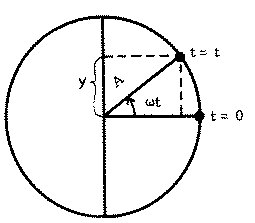
In the above figure, the position of a particle with angular speed  about a circle of radius A is projected onto the vertical diameter. We
arbitrarily let the projection be at the center of the diameter at t = 0, and
call y the displacement of the projection from the center. Then, at some later
time t, the particle will have turned through an angle
about a circle of radius A is projected onto the vertical diameter. We
arbitrarily let the projection be at the center of the diameter at t = 0, and
call y the displacement of the projection from the center. Then, at some later
time t, the particle will have turned through an angle  , equal to
, equal to
 t, and the
projection will have moved a distance
t, and the
projection will have moved a distance
y = A sin  t.
t.
Taking the expression for y and differentiating twice with respect to time, we obtain:
dy/dt =  A cos
A cos  t;
t;
d2y/dt=
- 2 A sin
2 A sin  t.
t.
By definition, d2y/dt2 is acceleration and  2
is a positive constant. From Newton's second law:
2
is a positive constant. From Newton's second law:
F = m d2y/dt2,
F = -m 2 A sin
2 A sin  t.
t.
Therefore, since A sin  t = y is the displacement
of the projection from the
center of the circle, our final equation is
t = y is the displacement
of the projection from the
center of the circle, our final equation is
F = -m 2 y = -ky,
2 y = -ky,
and the projection moves with simple harmonic motion, with the center of the diameter as the equilibrium position.
The circle of radius A is called the reference circle for the harmonic oscillation of amplitude A.
In the figure above, the period of the motion is the time required for one complete vibration. In this time, then, the projection must move from the center of the diameter, up to a maximum positive displacement, down to a maximum negative displacement, and back to the central point.
In the same time, then, the particle moving with angular speed  in a circular
path will go just once around the circle. The angle turned through by this
particle is 2
in a circular
path will go just once around the circle. The angle turned through by this
particle is 2 rad, and we see, from the definition of angular velocity:
rad, and we see, from the definition of angular velocity:
 =
=  /t,
that
/t,
that  = 2
= 2 /T,
/T,
where T is the period of the simple harmonic motion. Also, since the frequency f = 1/T,
 = 2
= 2 f.
f.
Thus, in our equation x = A sin  t, the coefficient
of t is 2
t, the coefficient
of t is 2 f or 2
f or 2 /T.
/T.
y1 = -1 cm to y2 = +2 cm?
OBJECTIVE:
PREREQUISITES:
Defining potential and kinetic energy and identifying systems to which the principle of conservation of total mechanical energy may be applied
Commentary:
Harmonic motion can be analyzed in terms of a particle with a fixed total energy oscillating in a potential-energy "well," i.e., in the presence of a potential that increases in either direction away from the equilibrium point. In fact, this approach was used in the text in the initial development of the concept of the restoring force. Now that we have derived a general solution to the equation of simple harmonic motion and can write expressions for displacement and velocity as functions of time, we are in a position to verify that the sum of kinetic and potential energy is, in fact, constant for a simple harmonic oscillator.
Find equations in a textbook on the InfoMall that express the potential and kinetic energy of simple harmonic motion as functions of time:
Enter those equations here:
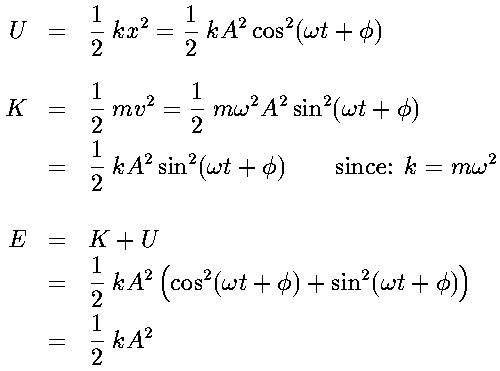
By applying the identity:
sin2 + cos2
+ cos2 = 1,
= 1,
we find total energy is constant and equal to (1/2)kA2.
This leads to several other useful results, such as an equation expressing velocity as a function of position, find or derive such an equation and enter it here:

Finally the equation:

relates the amplitude of the SHM to the total energy. It can be used to find the amplitude of the motion if the total energy is known and vice versa.
OBJECTIVES:
PREREQUISITES:
Defining angular velocity, acceleration, displacement, and torque Applying Newton's second law for rotation to solve simple problems
Commentary:
Using the equations:
F(x) = -kx, (1)
m (d2x/dt2) = -kx. (2)
we will outline a method for analyzing a mechanical system to determine whether it can be characterized by simple harmonic motion.
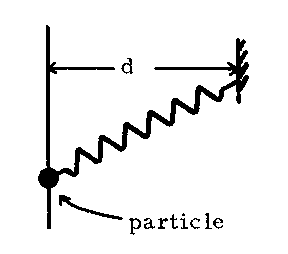
sin 

 .
.
The first thing to note is that this is true only if  is
in radians. Obviously sin 2.00° isn't 2. But 1° = 0.0174 rad, and sin(0.0349 rad) = 0.0348995 .
This approximation is good up to about 15.0° or 0.262 rad where we have
sin (0.262 rad) = 0.258. This is an error of only about 1%, so the
approximation is pretty good; the error in the period of a pendulum when the
amplitude is 15.0° is only 0.50%. Thus, even though a system actually does not
execute simple harmonic motion, if the angular displacement is kept small
enough its motion will be essentially simple harmonic. The listing below
summarizes a few of the many common examples of simple harmonic oscillators
along with the expressions for Fx or t. You should verify these
expressions for yourself. The determination of
is
in radians. Obviously sin 2.00° isn't 2. But 1° = 0.0174 rad, and sin(0.0349 rad) = 0.0348995 .
This approximation is good up to about 15.0° or 0.262 rad where we have
sin (0.262 rad) = 0.258. This is an error of only about 1%, so the
approximation is pretty good; the error in the period of a pendulum when the
amplitude is 15.0° is only 0.50%. Thus, even though a system actually does not
execute simple harmonic motion, if the angular displacement is kept small
enough its motion will be essentially simple harmonic. The listing below
summarizes a few of the many common examples of simple harmonic oscillators
along with the expressions for Fx or t. You should verify these
expressions for yourself. The determination of  , f, and T
for each system is
left to you as an exercise.
, f, and T
for each system is
left to you as an exercise.
 x.
x.


Fx = -2F0 (x/l).
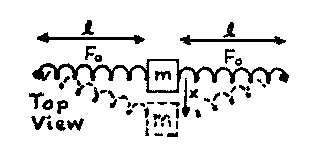
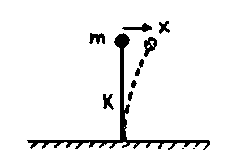
 .
For small displacements, the
motion is almost linear, and sin
.
For small displacements, the
motion is almost linear, and sin 

 .
Restoring force is
.
Restoring force is
Fx = -mg =
-mg(x/l).
=
-mg(x/l).
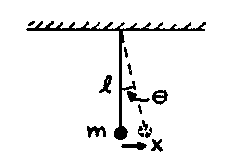
 . Or, use the restoring
torque:
. Or, use the restoring
torque:
 = -mgl
= -mgl with
I = l2m and
with
I = l2m and  = I
= I =
I d2
=
I d2 /dt2.
/dt2.
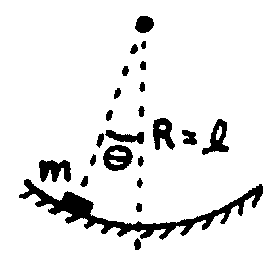
 = - lk·l
= - lk·l =
-k l2
=
-k l2 
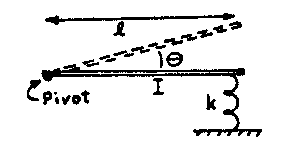
 = -k
= -k

Although many pendulums are designed to approximate the simple pendulum by having their mass concentrated at the end of a string or rod, a more general case is that of the compound pendulum or physical pendulum as illustrated in the figure below:
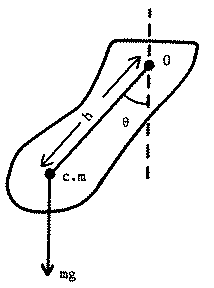
A compound pendulum consists of a rigid body of mass m suspended from an axis 0. The center of mass is a distance h from the axis. The torque about the axis 0 on the body is equal to the moment of inertia about the axis, I, times the angular acceleration:
 = I
= I = I(d2
= I(d2
 /dt2).
/dt2).
The restoring torque is provided by the weight mg:
 = -mgh sin
= -mgh sin  .
.
Therefore,
-mgh sin  =
I(d2
=
I(d2 /dt2).
/dt2).
If  is small, sin
is small, sin 

 and
and
-mgh  = I(d2
= I(d2 /dt2),
/dt2),
which is an equation for simple harmonic motion in terms of rotational variables.

F(r) = mgr/Re, and is directed toward the center of the earth. Use Re = 6.4 × 106 m for the radius of the earth: